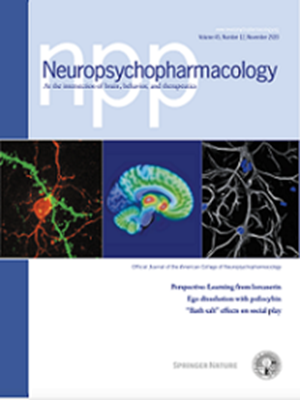Antipsychotics cause reversible structural brain changes within one week
IF 6.6
1区 医学
Q1 NEUROSCIENCES
引用次数: 0
Abstract
Determining the effects of antipsychotics on MRI brain structural metrics without the potential confounding effects related to the natural course of a psychotic illness is challenging. However, it is crucial to understand these effects to interpret the results of cross-sectional and longitudinal studies in medicated patients and, ultimately, to understand better the biological mechanisms driving antipsychotics’ effects. In this work, we aim to determine whether exposure to antipsychotics is associated with alterations in brain MRI structural metrics in the absence of disease effects. A randomized, double-blind, counter-balanced order, crossover, placebo-controlled study in healthy volunteers was performed. The study comprised two arms. Within arms, participants were randomized to receive daily doses of either the active compound (Arm 1= amisulpride 400 mg/day, N = 24; Arm 2= aripiprazole 10 mg/day, N = 24) for one week, followed by placebo or vice versa. We found increased MRI volume estimates in the left putamen and in the right caudate in the amisulpride condition as compared to placebo and increased right putamen volume estimates after aripiprazole compared to placebo. No other effects were found in cortical volume estimates, cortical thickness, cortical surface area, and T1-relaxation time. Striatal changes reversed within weeks of drug withdrawal. Short-term exposure to either one of two different antipsychotics results in a transient increase in striatal volume measured with T1-weighted MRI that normalizes rapidly on stopping treatment without cortical changes. Our findings suggest that striatal volumetric MRI differences detected in people with schizophrenia taking antipsychotics are, at least in part, attributable to pharmacological effects.

抗精神病药物会在一周内引起可逆的大脑结构改变。
确定抗精神病药物对MRI脑结构指标的影响而不存在与精神病自然病程相关的潜在混淆效应是具有挑战性的。然而,理解这些效应对于解释在服药患者中进行的横断面和纵向研究的结果,以及最终更好地理解驱动抗精神病药物作用的生物学机制至关重要。在这项工作中,我们的目的是确定在没有疾病影响的情况下,抗精神病药物暴露是否与脑MRI结构指标的改变有关。在健康志愿者中进行了一项随机、双盲、平衡顺序、交叉、安慰剂对照研究。这项研究包括两组。在组内,参与者被随机分配接受活性化合物的每日剂量(组1=阿米硫pride 400 mg/天,N = 24;第2组=阿立哌唑10mg /天,N = 24),服用1周,然后服用安慰剂,反之亦然。我们发现,与安慰剂相比,阿米硫pride组左侧壳核和右侧尾状核的MRI体积估计值增加,阿立哌唑组右侧壳核体积估计值与安慰剂相比增加。在皮质体积估计、皮质厚度、皮质表面积和t1松弛时间方面未发现其他影响。纹状体的变化在停药几周内就逆转了。短期暴露于两种不同的抗精神病药物中的任何一种都会导致纹状体体积在t1加权MRI测量中短暂增加,在停止治疗后迅速恢复正常,没有皮质变化。我们的研究结果表明,在服用抗精神病药物的精神分裂症患者中检测到的纹状体体积MRI差异至少部分可归因于药物作用。
本文章由计算机程序翻译,如有差异,请以英文原文为准。
求助全文
约1分钟内获得全文
求助全文
来源期刊

Neuropsychopharmacology
医学-精神病学
CiteScore
15.00
自引率
2.60%
发文量
240
审稿时长
2 months
期刊介绍:
Neuropsychopharmacology is a reputable international scientific journal that serves as the official publication of the American College of Neuropsychopharmacology (ACNP). The journal's primary focus is on research that enhances our knowledge of the brain and behavior, with a particular emphasis on the molecular, cellular, physiological, and psychological aspects of substances that affect the central nervous system (CNS). It also aims to identify new molecular targets for the development of future drugs.
The journal prioritizes original research reports, but it also welcomes mini-reviews and perspectives, which are often solicited by the editorial office. These types of articles provide valuable insights and syntheses of current research trends and future directions in the field of neuroscience and pharmacology.
 求助内容:
求助内容: 应助结果提醒方式:
应助结果提醒方式:


